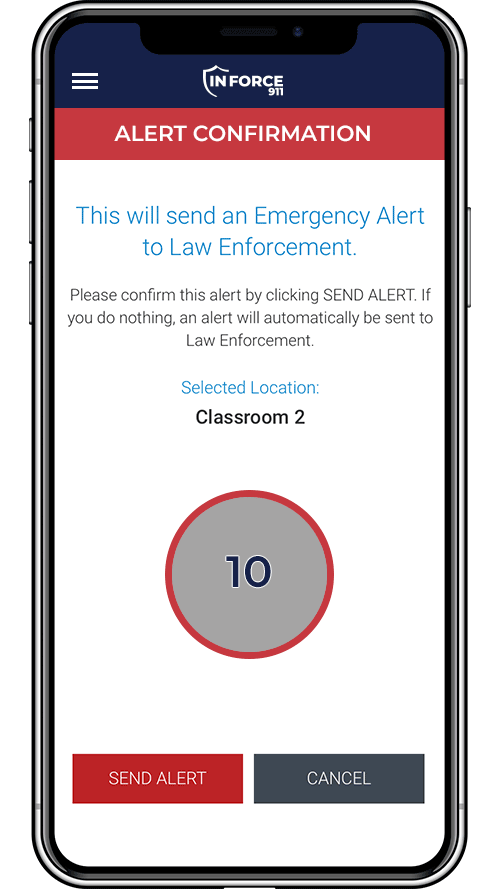Features and Functionality
IFT developed a software platform compliant with the FIPS 140-2 stringent encryption and security criterion, to alert designated law enforcement (in real time) upon recognition of a perceived life-threatening event. Upon recognition of a threat, the pre-identified end-user(s) initiates the notification process from any credentialed hardware and mobile device. The software platform contains many built-in technological redundancies to ensure accurate and up-to-date location information, supplementary to GPS and modes of connectivity.
In as few as four (4) seconds, law enforcement is immediately notified via with both audible and visual notification of the alert. Details such as the classification or type of threat (Active Shooter, Intruder, Medical Emergency or General), building address, name of the building, room number name of the initiating party are provided upon receipt of the alert. IN FORCE911 adheres to the strict standards of CJIS-5 compliancy regulations, allowing the application to run natively in law enforcement environments, including dispatch centers.
Upon receipt of the alert, a notification and communication window opens on in-vehicle computers and at the dispatch console simultaneously. Regardless of responding officer’s location, whether they are on or off duty, in or out of their vehicles, they will all receive the IN FORCE911 alert notification without delay. First responders also have immediate access to the digital building schematics, aerial photos and emergency operational plans and internet protocol (IP) based camera feeds from the school integrated through the IN FORCE911 application.
The window enables everyone experiencing the threat to share information as well; description of the assailant, location of the threat and other critical, pertinent and real-time information. As a result, members of the organization are prompted to take actions in coordination with pre-existing training, protocols, and procedures in the interest of best protecting themselves and those nearby for survivability.
Notification
IN FORCE911 enables someone experiencing a life-threatening situation to launch a silent alert from any device directly to all law enforcement devices simultaneously.
IN FORCE911 is designed to preside and populate in the forefront of all devices, the notification instantly provides specific information such as the building name and address, room number and the name of the end user. If the alert is sent from the mobile phone, law enforcement will be provided with the address of the threat location via GPS.

Communication

Communicating mission critical information and sharing real-time intelligence both internally and externally during an active threat has historically presented many challenges to mitigate risk, loss of life, and efficiently resolving an active threat.
IN FORCE911 removes this barrier in two ways:
- Once the initial alert is established, others within the building have access to a real-time, two-way chat via a communication window. This provides a critical advantage for staff in the building to be informed of what the threat is, the exact location, and any other pertinent details that can empower them to make educated decisions in accordance with their practiced training and response protocols.
- Secondly, law enforcement and additional first responders have access to streamlined and integrated digital floor plans, aerial imagery, emergency planning documents of the building(s) under threat. These customized building schematics and details are accessible on all responders’ devices to heighten situational awareness and facilitate the most effective and efficient entry of the building.
Internal Notification
IN FORCE911 provides faculty and staff the means to initiate an internal only notification.
This alert notification process deviates from our original alerting method, instead of staff notifying law enforcement directly, users would send the alert to the pre-determined administrators or user groups first. This process then enables key administration to assess the situation while maintaining control and oversight of the organization’s environment.
Upon assessment of the alert, administration may render a decision to forward the alert to one of the following recipients:
- all staff within the organization only;
- law enforcement and dispatch personnel only
- the combination of law enforcement and staff personnel simultaneously.

Each of these options for recipients could have customized internal notification messages and recipient lists, and would be predetermined upon onboarding for initial set up.
For example, should the administration feel as though the situation does not require law enforcement intervention due to the less severe nature of the threat, yet, determines remaining staff should be made aware, then the alert may be sent to all staff. They can end or release the alert when the NON-emergency is determined closed.
Conversely, should administration determine the alert requires immediate law enforcement intervention, then the alert is sent and received by law enforcement and dispatch in the three original destinations of receipt.
Finally, in the instance that both law enforcement and all staff must be made aware of the threat, the administration may notify all recipients simultaneously and without delay and first responding agencies will follow their Standard Operating Procedures accordingly and all communications, intelligence sharing and mission specific details will be shared at that time.
Reunification
Life threatening situations have proven that they’re not ever static, but rather, they evolve and move quickly. As a result, there are multiple phases to the tactical and operational response necessary to neutralize the threat. Because of the communication failures and inefficiencies associated with previous active shooter incidents, accounting for students and staff, providing medical triage and methodically clearing the building under threat has presented first responders with substantial challenges.
IN FORCE911 is the only solution to mitigate loss of life through the incorporation of consistent and clear best practices once an initial alert is sent, all the way to the closure of the situation.

Reverse Alert
Studies indicate that traditional attempts for dispatch to inform key administration of a potential threat doesn’t provide an effective way to mitigate a potential risk. In an effort to create a full circle, all-hazards approach to school safety, IN FORCE911 offers a Reverse Alert feature for law enforcement agencies to initiate a reverse notification to multiple buildings, officials and administration instantly and simultaneously of an imminent threat in the targeted area. This is accomplished by geo-targeting multiple locations on a map or manually selecting specific buildings to notify.

As with the primary alert feature, a subject line of why the alert was initiated is provided and the communication window enables intelligence sharing of critical details in real time as the situation unfolds.
Examples of why a Reverse Notification is used, include, but are not limited to the following:
- Domestic custodial disputes
- Bomb Threats
- Shelter in place orders
- Police Pursuits in progress
- Severe weather alerts
- Alert of chemical or hazmat spills
